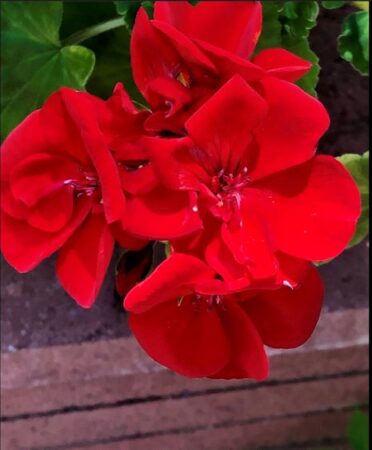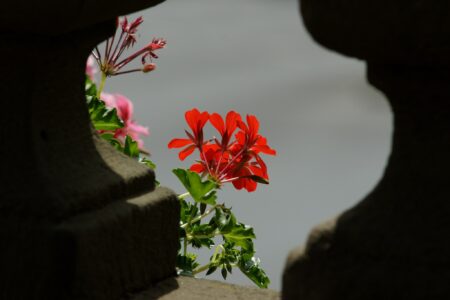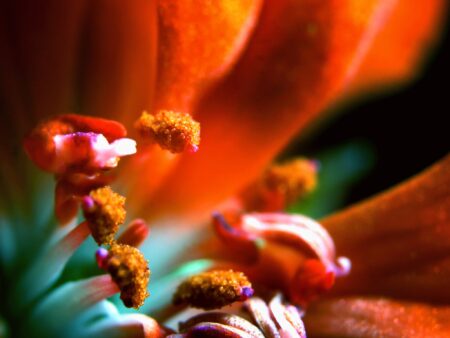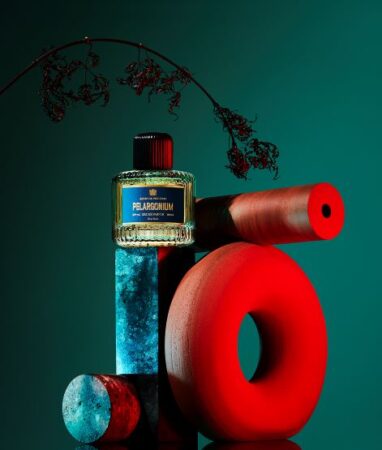
Oakleaf Geranium from Wikimedia
Almost a perfume in itself, geranium essential oil smells of roses, flowers, mint, and green herbs with subtle hints of wood. The flowers are small on this herb but that’s okay because they do not yield the bulk of the fragrance—the soft and fuzzy leaves are full of tiny glands packed with aromatics. If you grow them in your yard you know to brush them as you pass so you can enjoy the waft of scent they release. The essential oil is contained in tiny glands at the base of the velvety hairs on the leaves and is released when leaves are crushed or bruised, even rubbed between your fingers. What we commonly recognize as geraniums belong to the genus Pelargonium.

Rose Geranium Botanical illustration Pierre Redoute common use
Because the plant hybridizes readily, there are many different hybrids and cultivars with flowers and leaves of different colors and patterns. For essential oil production just, a few types are used—you may find essential oils of geranium, rose geranium, or Bourbon rose geranium, all of which have a distinctive rosy-floral fragrance. (Note: you will find different species names for your Pelargonium with graveolens, asperum and roseum among those listed). Rose geranium essential oil has a pronounced rosy note and is wonderful as a less-expensive substitute for rose otto or absolute. Bourbon Rose geranium is specifically grown on the island of Reunion and can be lovely. Solvent extraction yields the absolute of geranium that is somewhat greener and sharper that evolves to a nice long-lasting rose with mint tones. The concrete is similar but seems softer to me and may be used in solid perfumes.

Rodrigo Flores-Roux © Givaudan
Master Perfumer Rodrigo Flores-Roux, Vice President of Perfumery at Givaudan reminds that geranium is one of the four important ingredients in a fougère-structured perfume along with lavender, oakmoss, and coumarin. He further comments “… but I think it’s very risky to say that its first usage is Houbigant’s Fougere Royale, as I am almost sure that geranium and geranium essence had been used before that… its use has been documented in pharmacopeas from the Renaissance and after...” In terms of perfume use, he tells us that “It is true geranium essence is used widely in men’s fragrances. But it’s certainly present in numerous women’s fragrances. I have to mention Vent Vert de Balmain, accompanying galbanum and hyacinth, YSL’s Paris and Christian Dior J’adore, where it plays ricochet with Bulgarian rose and a sophisticated, elusive litchee note. Geranium is unforgettable in my adored Maja de Myrurgia soap. It’s also in Puig’s Agua Brava and overdosed in Venezia Uomo by Laura Biaggiotti. More recently, the gorgeous Geranium Odorata by Diptyque, with notes of fresh cologne, comes to my mind.”

Garden Geranium by Michelyn©
Scented geraniums were collected in their native South Africa by ships sailing the trade routes around the Cape of Good Hope and returning to the Netherlands and England in the 1600s. There was an active trade in unusual plants at the time between European nations and exotic locations like Africa. Quickly becoming popular, Pelargoniums were bred and hybridized to produce a wide variety of types and fragrances. For today’s gardener, the list of fragrances produced by Pelargonium geraniums is long and includes rose, coconut, peppermint, various citruses, strawberry, nutmeg, spice, apricot, mint, apple, almond, and ginger.

Geranium Leaves by Elise Pearlstine
Victorians adopted the unusual plant, putting fresh leaves on the table as decoration or in finger bowls for scent. They would grow the plants where the long skirts of ladies would brush up against them and release scent. Recipes from the time use fragrant leaves in puddings or gelatins or to flavor sugar for desserts. Victorian-style pound cake may be made with geranium-infused butter and infused sugar. Also passionate about flower arranging, Victorians found all kinds of messages in flowers. While they appreciated the more flamboyant flowers, they would tuck the fragrant leaves of a scented geranium into their Valentine bouquets for a touch of unexpected aroma. In the language of flowers, a rose geranium meant ‘preference’, a lemon-scented one stood for ‘unexpected meeting’, and a nutmeg scent portended an ‘expected meeting’. There was also apparently a fish-scented geranium that translated to ‘disappointed expectation’. Americans also adopted the plant when it arrived on their shores and Virginia housewives would add a rose geranium leaf to a bottle of sugar syrup. To this day, those who enjoy a rose-scented pipe tobacco can find rose geranium in some Lakeland blends.

Geranium for Protection from Wikimedia
Witches have long been associated with geraniums, both the traditional red and the more subtle scented types with their small pink or white flowers. With a feminine gender, geraniums are ruled by Venus and are used for fertility and protection. Red geraniums (the traditional type) warn of coming visitors and orient towards the direction of the coming visitors. Pink scented Pelargonium geraniums may be used in love spells whereas white are for fertility. Rose geraniums are for protection—rubbing fresh leaves on windows and doorknobs protect a home’s entrances. Cut flowers in the house will also guard those within. Folklore tells us that “snakes will not go / where geraniums grow” and that scented geraniums on a windowsill will repel insects. Nutmeg scented geranium may bring prosperity and luck while oak-leaved geraniums represent friendship.
Legend has it that the prophet Mohammed once hung his shirt on the branch of a mallow plant to dry after bathing in a nearby river. In celebration of this high honor, the mallow plant transformed herself into the richly perfumed rose geranium.

Geranium Petals from Wikimedia
Geranium essential oil is especially good in body care products, providing nourishment and healing to the skin while holding its fragrance well, even in the harsh process of soap-making. In Chinese medicine geranium is considered cool and moist, strengthening for Qi energy, and all-around good for heat, inflammation, nervous feelings, and anxiousness. In Africa, where the plants originated, Pelargonium geraniums are used for a variety of folk remedies, particularly respiratory problems. Geranium is a hormone-balancer and is useful for women in all stages of their menstrual cycle and also through menopause. Rather than moving emotions one way or another, geranium essential oil is a balancer, helping to stabilize emotions, de-stress, and create a sense of stability and open-ness to communication.

Nathalie Feisthauer courtesy of the perfumer
Master Perfumer Nathalie Feisthauer, who composed AEDES de VENUSTAS Pelargonium (and the first woman to sign an AEDES perfume in 2017), appreciates the unusual, rosy note provided by geranium and describes her use of scented geranium. “Geranium oil has many facets: the rosy part, but also a crushed minty part from the leaves that gives a more aromatic, more genderless tone” that also adds resinous and incense notes.” She adds “In AEDES Pelargonium I gave geranium the master place: I like to look at things in a different way, you find beauty in all things and in AEDES Pelargonium it’s the feeling of “patina-raw ingredients.”
If you are looking for a different take on rose, the bright and lovely, herby/minty scent of geraniums will win you over!
Elise Vernon Pearlstine, Editor and Author of Scent: A Natural History of Fragrance
Please read former editor Gail Gross’ review and Lauryn’s review of Aedes de Venustas Pelargonium

art courtesy of AEDES de VENUSTAS
Thanks to the generosity of Aedes Perfumery, we have a 100 ml tester of Pelargonium for one registered reader in the U.S. To be eligible, please leave a comment about what you learned about geranium in perfumery. You must register here. Draw closes 10/1/2022.
Follow us on Instagram at @cafleurebonofficial @elisepearlstine @rodrigofloresroux @nathalie.feisthauer @aedes_de_venustas @aedes_perfumery
This is our Privacy and Draw Rules Policy
We announce the winners only on our site and on our Facebook page, so like Çafleurebon and use our blog feed or your dream prize will be just spilled perfume.
